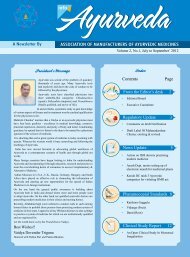ishing You Happy New Year - amam-ayurveda.org
ishing You Happy New Year - amam-ayurveda.org
ishing You Happy New Year - amam-ayurveda.org
You also want an ePaper? Increase the reach of your titles
YUMPU automatically turns print PDFs into web optimized ePapers that Google loves.
Pharmocopial Standards For Vasavleha<br />
Vasavleha<br />
(AFI, Part-I; 3:26)<br />
Definition:<br />
Vasavleha is a semisolid avaleha preparation made with the ingredients in<br />
the Formulation composition given below.<br />
Formulation composition:<br />
1. Vasaka (Vasa API) svarasa Adhatoda vasica Lf. (Fresh) 768 g<br />
2. Sita (Sarkara API) Sugar candy 384 g<br />
3. Sarpi (Goghrita API) Clarified butter from cow’s milk 96 g<br />
4. Pippali API Piper longum Fr. 96 g<br />
5. Madhu API Honey 384 g<br />
Method of preparation:<br />
Take all ingredients of pharmacopoeial quality.<br />
Take fresh leaves of Vasa, wash with water. Chop the leaves to about 2.5<br />
cm, grind into a paste and prepare vasa svarasa through puta paka vidhi.<br />
Clean, dry, grind Pippali into fine powder and pass through sieve no. 85.<br />
Add powdered Sharkara to Vasa svarasa, heat mildly and filter through<br />
muslin cloth, after complete dissolution of Śarkara. Stir continuously<br />
while heating on mild fire.<br />
Concentrate the above mixture by continuous stirring on low fire.<br />
Add Gh¨ta and Pippalī to the above mixture and mix well. Continue<br />
heating till the preparation reaches the required consistency confirmed by<br />
the formation of a soft ball that does not disperse in water and cool to<br />
room temperature. Add honey and again mix well by continuous agitation<br />
with stirrer to make a homogeneous mixture.<br />
Pack it in tightly closed containers to protect from light and moisture.<br />
Description:<br />
Dark brown coloured, semi solid, malleable, sticky preparation with odour<br />
of ghee; taste bitter and pungent.<br />
Identification:<br />
Microscopy:<br />
Take about 5 g of sample dissolve in sufficient quantity of n-hexane for<br />
removal of ghee.<br />
Repeat the procedure with two further increments of solvent pouring<br />
out solvent each time, wash the sediment with warm water, followed by<br />
cold water repeatedly till a clear sediment is obtained. Take a few mg of<br />
the sediment, mount in 50 per cent glycerine and observe the following<br />
characters. Simple starch grains with concentric hilum, abundant polygonal<br />
perisperm cells packed with starch grains (Pippalī); multicellular,<br />
uniseriate, warty covering trichomes, sessile glandular trichomes with<br />
quadricellular head, fragments of lower epidermis showing the presence<br />
of diacytic stomata, cigar-shaped crystoliths (Vasa).<br />
Thin layer chromatography:<br />
Extract 5 g of avaleha with 100 ml of methanol under reflux on a waterbath<br />
for 30 min.<br />
Filter, concentrate to 25 ml and carry out the thin layer chromatography.<br />
Apply 10 μl of the extract on TLC plate and develop the plate to a distance<br />
of 8 cm using ethyl acetate : methanol : ammonia (8 : 2 : 0.2) as mobile<br />
phase. After development, allow the plate to dry in air and examine under<br />
ultraviolet light. It shows major spots at Rf 0.34 (vasicine), 0.74, 0.96<br />
(piperine) under ultraviolet light (254 nm) and at Rf 0.77 (fluorescent<br />
blue), 0.89 (blue), 0.96 (fluorescent blue – piperine) under ultraviolet light<br />
(366 nm). Derivatise the plate with modified Dragendorff’s reagent and<br />
observe under visible light. It shows two orange coloured spots at Rf 0.34<br />
and 0.96.<br />
Physico-chemical parameters:<br />
Loss on drying: Not more than 12.16 per cent,<br />
Total Ash: Not more than 2.5 per cent,<br />
Acid-insoluble ash: Not more than 0.15 per cent,<br />
Alcohol-soluble extractive: Not less than 20 per cent,<br />
Water-soluble extractive: Not less than 60 per cent,<br />
Total sugar: 83 to 88 per cent,<br />
Reducing sugars: 44 to 45 per cent,<br />
Non-reducing sugars: 38 to 43 per cent,<br />
pH (10% aqueous solution): 4.35 to 4.9,<br />
The formulation contains not less than 0.2 per cent of vasicine and not less<br />
than 0.2 per cent of piperine when assayed by the following methods.<br />
Estimation of vasicine:<br />
Dissolve 2 mg of vasicine in 25 ml of methanol in a volumetric flask.<br />
From this stock solution pipette out aliquots of 2 to 6 ml and make up<br />
the volume to 5 ml in volumetric flasks with methanol. Apply 10 ml of<br />
each standard solution (corresponding to 320 to 960 ng of vasicine) on<br />
TLC plate. Develop the plate to a distance of 8 cm using ethyl acetate:<br />
methanol: ammonia (8 : 2 : 0.2) as mobile phase.<br />
After development, dry the plate and scan in TLC scanner at a wavelength<br />
of 298 nm.<br />
Note the peak area under the curve for a peak corresponding to vasicine<br />
and prepare the calibration curve by plotting peak area vs amount of<br />
vasicine.<br />
Extract accurately weighed about 5 g of Vasavaleha in methanol (25 ml<br />
x 5). Filter the extract, pool, concentrate and adjust the volume to 25 ml.<br />
Apply 10 ml of test solution on TLC plate and develop, dry and scan the<br />
plate as described in the preceeding paragraph for calibration curve of<br />
vasicine. Calculate the amount of vasicine in the test solution from the<br />
calibration curve of vasicine.<br />
Estimation of piperine:<br />
Dissolve 5 mg of piperine in 100 ml of methanol. From this stock<br />
solution, pipette out 0.8 to 4.8 ml aliquots into 10 ml volumetric flasks<br />
and make up the volume with methanol to prepare standard solutions of<br />
4 to 24 μg / ml. Apply 10 ml of each standard solution (corresponding<br />
to 40 to 240 ng) on TLC plate and develop the plate to a distance of 8<br />
cm using dichloromethane: ethyl acetate (7.5: 1) as mobile phase. After<br />
development, dry the plate and scan in TLC scanner at a wavelength of<br />
337 nm. Note the peak area under the curve for a peak corresponding to<br />
piperine and prepare the calibration curve by plotting peak area vs amount<br />
of piperine.<br />
Extract accurately weighed about 5 g of Vasavaleha with ethyl acetate (25<br />
ml x 5). Filter the extract, pool, concentrate and adjust the volume to 25<br />
ml in a volumetric flask. Apply 10 ml of test solution on TLC plate and<br />
develop, dry and scan the plate as described in the preceding paragraph for<br />
calibration curve of piperine. Calculate the amount of piperine in the test<br />
solution from the calibration curve of piperine.<br />
Other requirements:<br />
Microbial limits: With in specified limits<br />
Aflatoxins: With in specified limits<br />
Storage: Store in a cool place in tightly closed containers, protected from<br />
light and moisture.<br />
Therapeutic uses: Kasa (cough); Shvasa (Dyspnoea); Jvara (Fever);<br />
Raktapitta (Bleeding disorders); Rajayakshma (Tuberculosis);<br />
Parshvashula (intercostal neuralgia and pleurodynia); Hritshula (Angina<br />
pectoris).<br />
Dose: 12 g daily in divided doses.<br />
Anupana: Milk, Water.<br />
www.<strong>amam</strong>-<strong>ayurveda</strong>.<strong>org</strong> 15


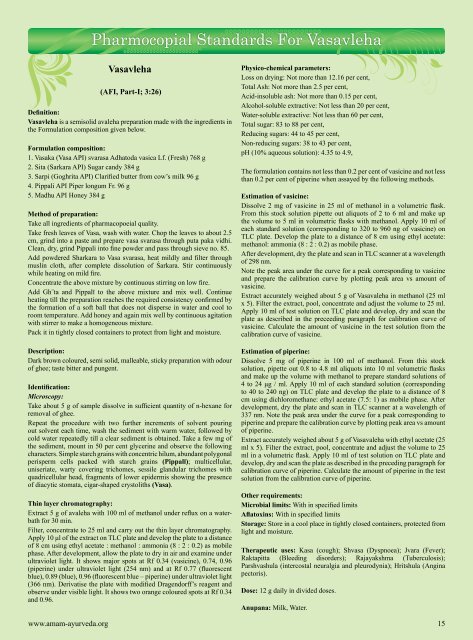

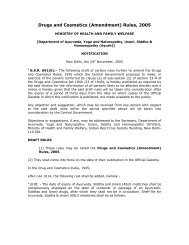
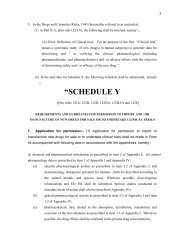
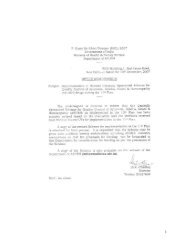


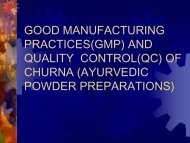
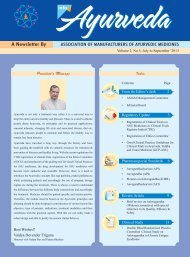
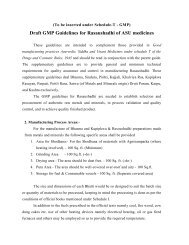
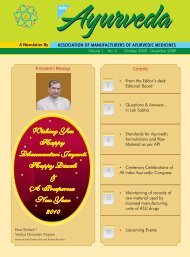
![[To be published in Gazette of India Part II Section 3, sub-section iii]](https://img.yumpu.com/28570283/1/190x245/to-be-published-in-gazette-of-india-part-ii-section-3-sub-section-iii.jpg?quality=85)

